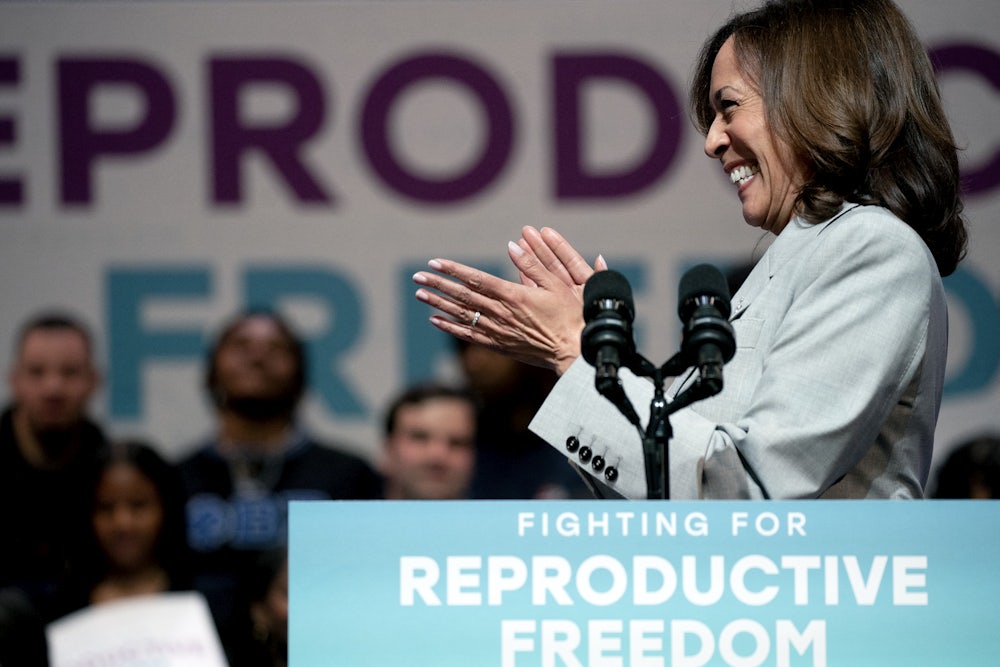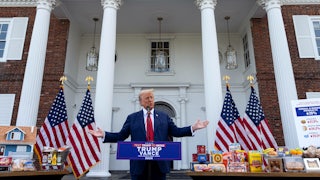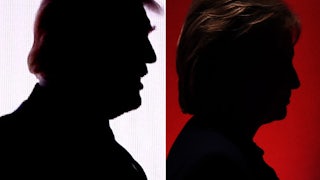Let’s talk about freedom—because Kamala Harris certainly is, starting with her first campaign ad: “There are some people who think we should be a country of chaos, of fear, of hate,” she intoned. “But us, we choose something different. We choose freedom.” The ad underscored the message by cuing Beyoncé’s “Freedom.”
Harris has since made “freedom” a central campaign message, and you will surely hear a lot about it at the Democratic National Convention this week: Wednesday night’s theme is “A Fight for our Freedoms,” for example. “Some of us are old enough to remember when it was Republicans who were talking about freedom,” Governor Tim Walz said during his debut as Harris’s running mate. “It turns out now what they meant was the government should be free to invade your doctor’s office.”
Indeed, Republicans have long exercised a rhetorical monopoly on “freedom”: It was a touchstone for Ronald Reagan, who used the word a dozen times in his farewell address, describing America as “still a beacon, still a magnet for all who must have freedom, for all the pilgrims from all the lost places who are hurtling through the darkness, toward home.” (The Gipper had a somewhat more sanguine view of immigrants than today’s GOP.) George W. Bush uttered the word 27 times in his second inaugural, outlining what he styled his “freedom agenda.”
This history makes Harris’s oratorical appropriation all the more striking—and overdue. But a confluence of events, from Donald Trump’s rise and Roe’s fall to a behind-the-scenes effort among some Democratic operatives to reframe “freedom” and rebrand the party, have helped position Harris to seize back this messaging high ground.
“We have a real chance to redefine the party moving forward and the ability to have a real contrast to what really is kind of Creepyville for the Republicans,” said Mark Riddle, a Democratic strategist who has pushed the “freedom-frame” for years.
“It is a deeply held value, which we never really talk about because there’s an assumption that it’s always there,” Stephanie Schriock, former president of Emily’s List, told me. “But freedom will disappear if you don’t talk about it.”
Democrats have a long history with the
rhetoric of freedom. President Franklin D. Roosevelt famously enunciated his “four freedoms”—freedom of
speech, freedom of religion, freedom from fear, and freedom from want—in his
1941 State of the Union speech. In
his inaugural address, John F. Kennedy exhorted his “fellow citizens of the
world: Ask not what America will do for you, but what together we can do for
the freedom of man.” In his “I
have a dream” speech, Martin Luther King spoke of being “Free at last. Free at last. Thank God
almighty, we are free at last.” (He also drew a much
bigger crowd than Trump.)
And yet Republicans made it their own talking point, from Ronald Reagan’s and George W. Bush’s oratory to the name of the far-right House caucus of extremists to the petulant Iraq War-era silliness of rechristening French fries sold in the House and Senate cafeterias as “freedom fries.” (My colleague Michael Tomasky has detailed the history of the right’s appropriation of the term.) They succeeded in part because they built a simple, coherent message around what GOP strategist Grover Norquist dubbed the “leave us alone” coalition, which defined freedom as absence of government intrusion (taxes and regulations, for example). That formulation was an example of what the late philosopher Isaiah Berlin termed “negative freedom”—freedom from, in other words. Democrats tend toward what Berlin called “positive freedom”—freedom to. “The freedom not just to get by, but get ahead,” as Harris put it in her debut ad. “The freedom to be safe from gun violence; the freedom to make decisions about your own body.”
The fight to define freedom isn’t new. The cognitive linguist George Lakoff published Whose Freedom? The Battle Over America’s Most Important Idea in 2006. “Where most Americans in the last century have seen an expansion of freedom, these conservatives see curtailments of what they consider ‘freedom,’” he wrote in The New York Times that year. “What makes them ‘conservatives’ is not that they want to conserve the achievements of those who fought to deepen American democracy. It’s the reverse.”
Trump’s surprise 2016 victory left Democrats wondering how to define and articulate a vision to which voters would actually respond, especially in the Midwest states that had failed to hold as the party’s electoral firewall. Many worried that the party communicated too programmatically—Hillary Clinton was awash in policy proposals in 2016 but lacked vision—and couldn’t connect with disaffected voters at a gut level.
A mix of party leaders, strategists, and donors engaged Riddle and others to address the conundrum under the auspices of Future Majority, a political nonprofit aimed at rebranding the party. Launched in 2017, the group kept a deliberately low public profile while thinking through what a successful rebrand would look like. It drew talent and ideas not only from political operatives but also from Hollywood writers and corporate branding experts.
“Thinking about building a brand strategy is twofold,” Jeremy Tucker, a brand consultant who worked with Future Majority, told me. “What does the market want? And what does the organization—the party in this case—what could they stand for?” The Future Majority team met with more than 300 Democratic officials, operatives, and activists in 2017 and 2018. The first question they asked, Tucker recalled, was: Who owns the Democratic Party brand? The Democratic National Committee “very explicitly, verbatim, said, ‘We don’t own the brand. We don’t want it. We do presidential elections.’” The Democratic Senatorial Campaign Committee demurred, as well. The Democratic Congressional Campaign Committee, then chaired by Ben Ray Luján (who would win a Senate seat in 2020), was “the first to say, ‘What do you mean, own the brand? Is that possible?’” Tucker told me. Future Majority started working with the DCCC on its messaging leading up to the 2018 elections when Democrats retook the House. “They were incredibly helpful and influential in 2018,” Dan Sena, who was the House campaign committee’s executive director, told Politico in 2019.
The group used polling and focus groups, especially targeting the most closely contested House districts and swing states, asking “a lot of open-ended questions, which is rarely done in political polling, but that’s how in commercial brand strategy you get to the underlying consumer psychology of what buyers—or in this case voters—actually want,” Tucker said. Overall, Future Majority has spent $100 million and polled over 215,000 voters, according to Riddle, and looked at over 30 million data points.
(Some of the questions were abstract to the point of sounding silly: A May 2021 study included a question on which party voters would prefer to have in charge during a zombie apocalypse, with 60 percent of independents and even 40 percent of Democrats choosing the GOP. “Republicans are perceived as providing strength and security through aggression,” the analysis concluded, adding: “Black voters unilaterally chose Democrats because of the belief that Republicans might shoot them.”)
The centrality of “freedom” to American voters—and Democrats’ opportunity to engage on it—popped out of the research early: A stunning 91 percent of voters identified it as the most important value to them. It had multiple messaging virtues: Freedom is sufficiently broad that a variety of policies can be explained through it. “You can have a million different iterations of a campaign,” Tucker, the brand expert, told me. “The more you can say and be one idea to people over and over and over again, then you own that idea.… It’s not stay on message, it’s stay on philosophy.”
Establishing freedom as a shared common value also makes voters more receptive to Democrats’ policy proposals. It becomes the frame through which they can discuss specifics. “People need to feel what it is you’re bringing to them … before you can get elbow-deep in policy,” said Fentrice Driskell, Democratic leader in the Florida House and a freedom frame advocate. “Start with the value: the freedom to be healthy, prosperous, and safe. You tell people what they deserve and what freedom would look like.” Then you get into the details of policy. “We kind of got lost in ‘Let’s put out 53 points on the issues we care about,’” Riddle told me. “If you lead with your values then you can talk about the issues underneath. If you just talk about the issues, you can start losing people.”
Some activists pushed back on the freedom messaging, favoring more traditional Democratic emphases on equality and justice. But using a technique called marginal effects regression, Future Majority found that improving voters’ trust on individual freedoms did more to get them to vote Democratic than any other issue. “There’s always going to be the tension in the Democratic coalition of which value frames we should be emphasizing,” Stephen Clermont of Change Research, which does Future Majority’s polling, told me. “There’s a lot of pressure to talk about equality and justice—but freedom is foundational to all of that.”
Modeling its approach on that of the longtime GOP messaging guru Frank Luntz, Future Majority pumped out a steady stream of memos, reports, and playbooks on how to reach persuadable voters. “In a partisan world our viewpoint is Dems will get Dem votes,” Riddle said. “GOP gets GOP votes. So what would the swing voters want?” It aimed to use data-backed messaging to help change the way the party presented itself, and it built an ecosystem of like-minded strategists, donors, fundraisers, and elected officials. “People are starting to realize that there’s this movement that we should not concede this value to our opposition,” Driskell said. “The more Democrats have been talking about this, the more Democratic leaders have been picking this up.”
(The people involved in the effort are careful not to take credit for Harris deploying the freedom frame, but they all express excitement that the message is now at the pinnacle of Democratic politics. “What’s the thing people want most? Freedom. What’s the thing they fear the most? Chaos. What did she say in her first speech? This campaign is about freedom, not chaos,” noted Billy Ray, a Hollywood screenwriter—he wrote and directed 2003’s Shattered Glass, about disgraced TNR reporter Stephen Glass—turned messaging guru who has helped Future Majority. “I have no contact with that campaign, but these are the ideas we’ve been pounding for seven years.”)
The freedom frame started getting traction. “You
know what? We need to take the word freedom back,” Senator Patty Murray told an
Emily’s List dinner in 2018. “We need to stand for freedom for children, women,
workers, and families. Freedom to go to school to learn, rather than do active
shooter drills, and go to college without crushing student debt. Freedom to
make your own choices about your own body.” Former Indiana Mayor Pete Buttigieg spoke articulately
about freedom during his
2020 presidential run. Senator Bob Casey introduced a “five freedoms for
America’s children” plan in 2021, and then the following year fellow
Pennsylvanian Josh Shapiro made
freedom central to his
successful gubernatorial bid, as did Gavin
Newsom in California.
“It’s a very powerful set of values,” said Schriock, who is not affiliated with Future Majority. “The odd thing is it’s so simple in one way, but it took a little bit of research and a way to talk about it more broadly.… It’s kind of the Republican thing, but it’s not—it’s not who they are anymore. It’s who we are. It’s who we’ve always been. We just didn’t talk about it.”
Trump’s ascension gutted the GOP’s message of freedom through limited government. He is a conservative of convenience who doesn’t so much have a political philosophy as a need to enrich and empower himself and punish his enemies. He replaced the GOP’s ostensible limited-government ethos with explicitly intrusive-government Republicanism, interested in leaving alone only those who have the money and privilege to insulate themselves. For the rest of us, the GOP will use government to censor classrooms, punish private corporations, and ban apps, in pursuit of what Ron Brownstein has called a “systematic drive … to roll back seemingly long-settled civil rights and liberties.”
That revanchist assault is antithetical to any real notion of freedom. “The Right is returning to its authoritarian roots of decades ago,” one op-ed warned last year. “Right wing nationalists now talk about using government to pursue ‘conservative’ ends.… Trump himself has openly called to ‘terminate’ the Constitution, presumably in pursuit of his personal ambitions.” The author was longtime GOP operative Frank Donatelli, a former Reagan aide who was deputy chairman of the Republican National Committee as recently as 2008.
So emphasizing freedom is “an especially strong rhetorical approach right now because of the GOP’s creeping authoritarianism—its determination to tell teachers what must and must not be taught in classrooms, to dictate what doctors are allowed to tell patients, and what procedures (even emergency surgeries) they are allowed to perform,” Jeff Shesol, a longtime Democratic speechwriter (and unaffiliated with Future Majority), told me.
And no issue has catalyzed the Democrats’ ability to reclaim “freedom” like abortion and the 2022 Dobbs decision.
“Abortion access is the canary in the coalmine,” Judith Lichtman, former president of the National Partnership for Women & Families, told Schriock when the latter became Emily’s List president in 2010. “And when it falls—and it will—everything else will fall unless we fight like hell.”
Schriock was skeptical, she recalled to me, that the Supreme Court would actually dump Roe. But then Trump stacked the body, and in 2022 Dobbs canceled Roe, stripping a majority of Americans of a right they had held for a half-century. “Pre-Dobbs, a lot of the polls we did showed that the Republican messages on freedom were more believable and people associated that more with Republicans,” recalled Clermont, the pollster. “That changed pretty rapidly after Dobbs.”
Kamala Harris quickly grasped that connection and took point for the Biden administration on reproductive freedom. “When Dobbs happened and the right to an abortion was taken away as a federal guarantee, the vice president was very clear that she wanted to talk about it in a broader frame—abortion specifically, but also the threat to our freedoms more broadly,” Jamal Simmons, who was Harris’s communications director at the time, told me. He added: “She talked about how her nieces and stepdaughter would have fewer rights than her grandmother.… That’s the first time in American history that we have taken rights away from people who previously had them.”
Having led on reproductive freedom
positioned Harris well to make it a central point in her campaign. Biden had
similar plans—he mentioned freedom four
times in his video announcing his reelection bid and six times in his
follow-on ad—but his message was subsumed by age. As a younger person and a woman,
Harris is better able to make the case.
“Particularly the women’s side of the party has been pushing the freedom frame for quite a while,” Schriock told me.
Nevertheless the fight isn’t done.
“Democrats have an edge in personal freedom, we don’t have the edge on economic
freedom,” Clermont, the pollster, told me, adding that Democrats should “frame
all the investments and programs that we do support” in terms of freedom. Paid
family leave, for example, “does give people the freedom to decide to have a
child.”
If Harris can continue making the case for freedom and Democrats can catch the GOP on its economic component, it will rearrange the political landscape for a generation.
“Democrats have tapped into a vein that runs deep in the American psyche, and I think this is going to lead to a lot of wins until the Republicans figure out how to talk about freedom in a way that makes sense,” Gretchen Barton, a Democratic consultant who also worked with Future Majority, told me. “Republicans should be put on notice that we’re going to keep going after language that we have ceded in the past.”








